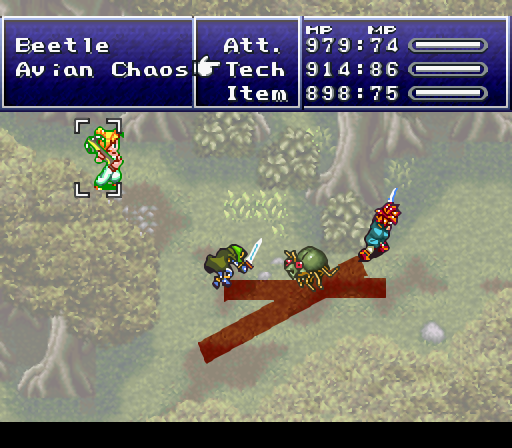 |
| The most gloriously inaccurate box art ever.* |
Picture this: You're a teenage guy whose biggest concern is the local town fair. One day, your quirky inventor friend creates a device that accidentally becomes a time machine. You have a thrilling adventure in the middle ages, but later, things get complicated, and you end up far in the future. So far, in fact, that doomsday has already long passed, leaving the world a rotting shell of what it once was. So begins Chrono Trigger, one of the greatest games to come out of Squaresoft's golden age, and its heroes' choice to use their newfound ability to travel through time to find a way to stop the apocalypse, even though it occurs long after their lifetimes, is not the first nor the last of the many things this game does very right.
To start off, the game makes great use of its active time battle system, wherein attacks are chosen from a menu, as in turn-based games, but rather than proceeding in turn, actions are determined by a constantly refilling meter. This is not an uncommon thing in RPGs, but different combinations of characters having different combination skills, called Double and even Triple Techs, adds a slight layer of strategy as to whether you use smaller actions as they become available or wait for multiple characters to be ready at once so they can attack in unison.
 |
| The "x" in X-Strike stands for X-ellent design choice. Thanks, folks, I'll be here all week. |
 |
| You know. In case you couldn't tell. |
I could go on about the big names involved, but one of the areas where Chrono Trigger truly shines is in its use of time travel. Time travel is not an uncommon trope in storytelling, but it is seldom utilized so well with the scope and consistency that Chrono Trigger shows, with very few discrepancies in the way the game handles time travel (and even those have been theorized away by some of the more hardcore fans). The game ranges from the primitive stone age to the aforementioned post-apocalypse, and every era manages to have its own identity while still feeling like a coherent piece of the history of this world. The game's cast of playable characters is very interesting as a result, including a cursed knight who wields a magic sword and a cavewoman who fights with her bare fists, among others. What I love about this game's party is that each of the characters from different eras could easily be seen as a main protagonist in their own era, but this game brings them all together to form what is one of my favorite JRPG parties.
 |
| You may recognize that guy in the back as a non-bear version of my avatar. There is a reason for that. |
 |
| Pick a time Gate, any time Gate! |
When you do decide to face the final boss, there end up being several different ways to go about it, and each of these different ways results in a different ending or permutation of one of the endings. This is also affected by when in your adventure you face the fight, and there are some endings that you either cannot get or at least can't reasonably get without odious amounts of grinding on your first playthrough. To that end, this game actually coined the phrase "New Game +" (although the concept had been used before), to allow you to go for the various endings. All told, the game has 12 endings, and the PS1 and DS ports add an extra 13th ending for good measure. Also, as I mentioned there are slightly different versions of each ending depending on various things including the state of your party when you reach the final battle. It's safe to say that this alone gives the game a good amount of replayability that makes up for its relatively shorter story, although even if you only ever beat the game once with the most standard ending, you'll still get a lot of fun out of it. It's really a shame that we still haven't gotten a proper sequel to it (Chrono Cross on the PS1 exists, yes, but its gameplay and story just don't hold quite the same charm; for big fans of Trigger, however, I'd still recommend it).
All in all, Chrono Trigger is a phenomenal game that any one who considers themselves a fan of RPGs should definitely play, while also serving as a great introduction for new fans of the genre because of its lower difficulty cap. Great gameplay, story, and visuals make it one of my favorite video games of all time, Much has been written about this game and all the ways in which it succeeds, so perhaps I needn't stress this so much, but I highly recommend this title. Give it a try, and I promise you won't regret it.
 |
| You might still be hungry, though. |
---
*In short: Crono isn't left-handed, Marle doesn't use Fire magic, you don't fight that monster in that location, and I'm not sure you can even have that party at the time you do fight him. The clothes aren't in-game because the sprites don't change with different armor, so that could go either way.
No comments:
Post a Comment